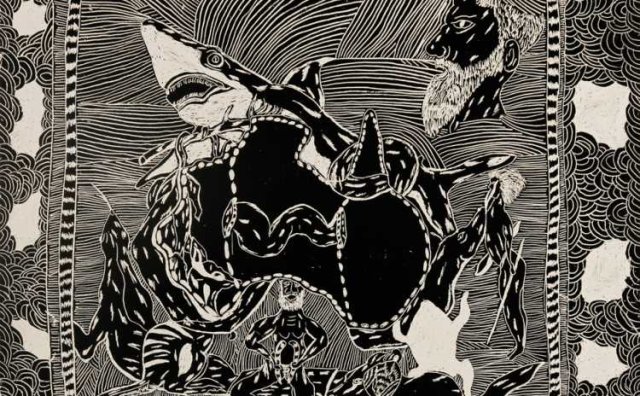
When the Sky Fell, Legacies of the 1967 Referendum
Curated by Clothilde Bullen
Perth Institute of Contemporary Arts in partnership with Aboriginal Art Centre Hub WA
Until August 20
RightWrongs, ’67 Referendum — the WA Story
State Library of Western Australia
Until September 2
Two very different exhibitions communicate critical evidence about the Aboriginal experience of the 1967 referendum, through which the Australian constitution was amended to remove the racist provisions of sections 51 and 127.
That victory certainly did not end racism in Australia, but opened up the possibility of a broader, unfinished struggle.
The State Library of Western Australia has gathered a wide variety of historical artefacts and images telling the story of Aboriginal oppression since white settlement — and the fight back against it.
A telling example is the first town map of Perth on which can be seen all the lakes and wetlands that were filled in to create the current cityscape. Also to be seen is a map showing the exclusion zone — the area that Aboriginal people had to leave before sunset every night.
There is a killer quote from Tommy Dower, an Aboriginal guide used by Alexander Forrest’s expedition into the Kimberley region. Forrest was the ancestor of Fortescue Metals Group owner Andrew Forrest and the founder of the family fortune.
“Where those old colonists be?” Tommy Dower asked. “Who mindem sheep for old colonist and findum waterhole and showem whitefellow way overland to South Australia!? Why blackfellow.”
Images of the Westralian Aborigine newspaper, published in the 1950s, demonstrate that there was always resistance. An important feature was the support of the union movement for the referendum.
The Perth Institute of Contemporary Arts’ (PICA) approach to the subject is different. A beautiful collection of art works from all over WA has been put together illustrating a variety of perspectives.
The thrust of the curating, Clothilde Bullen says in the exhibition guide, is to explain that the constitutional changes, while sweeping, completely disregarded the complexity of Indigenous communities. She seeks to “unpack some of the individual and communal generational responses”.
Many of the art works, especially those by older painters, reveal a nostalgic view of station life in the north of WA, pre-1967. Aboriginal communities were tolerated on the huge stations as long as the young men provided cheap labour.
But hot on the heels of the referendum came equal pay — upon which the station owners mechanised their operations and threw Aboriginal people off the land. The coming of the road train trucking system, which eliminated droving, summarises it. That process is not plainly stated in the exhibition, creating a confusion about what statement is being made about the referendum.
John Prince Siddon contributes a number of works that reflect the effects of mechanisation and land theft. His near-brutal work, Dog eating snake is unmistakable: the introduced dog is devouring the native snake with one of the stars of the Australian flag in the background.
Many of the works are meditative and all are beautiful. The collection is wonderful to walk through.
However, the exhibition title, When the Sky Fell, is never explained. Upon whom did the sky fall? Was the 1967 referendum a cataclysm for Aboriginal people or for racists?
In fact, the referendum was a significant milestone alongside others, like equal pay. The mixed results of all these partial victories will be clarified by further anti-racist fights.
Like the article? Subscribe to Green Left now! You can also like us on Facebook and follow us on Twitter.